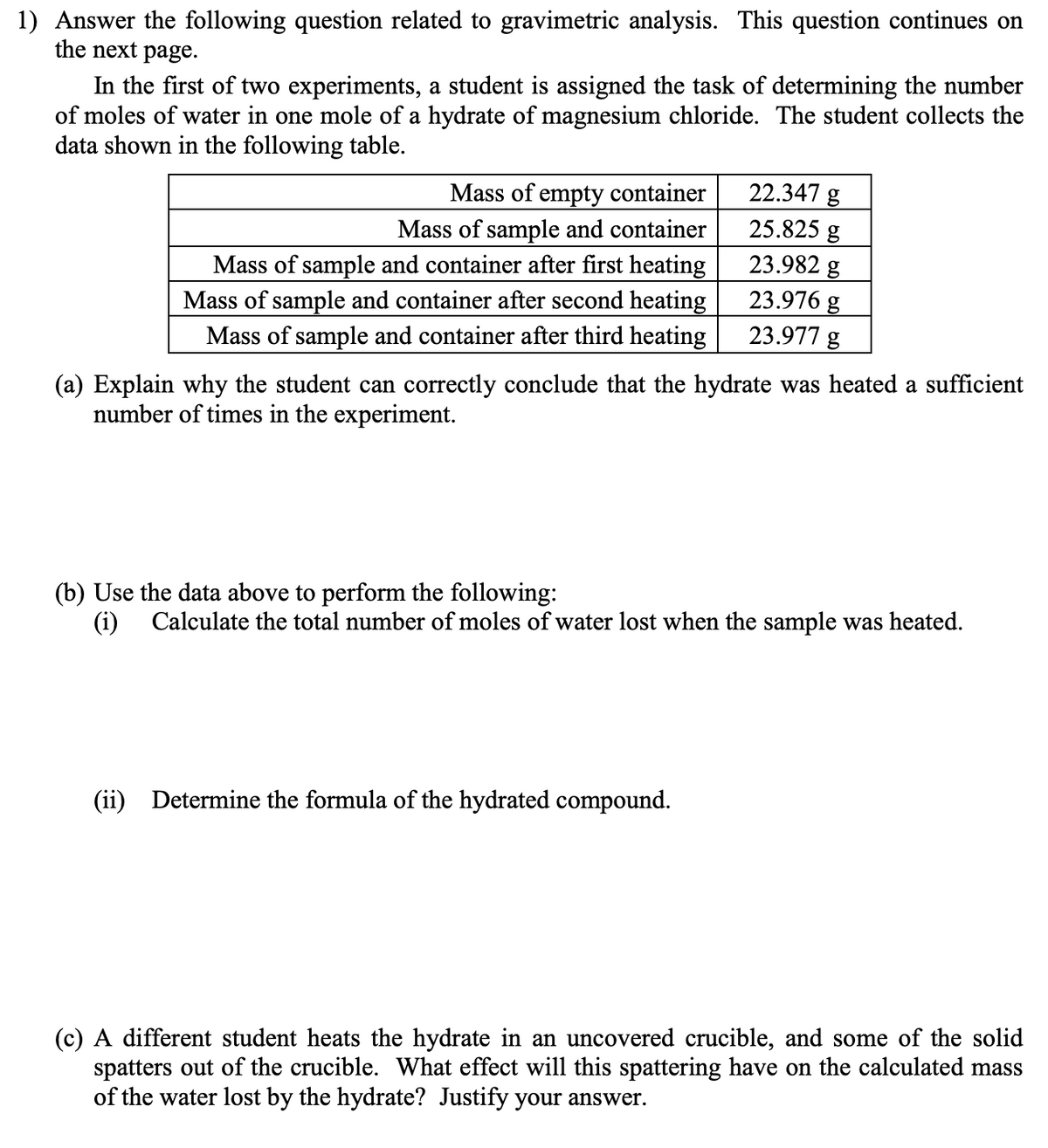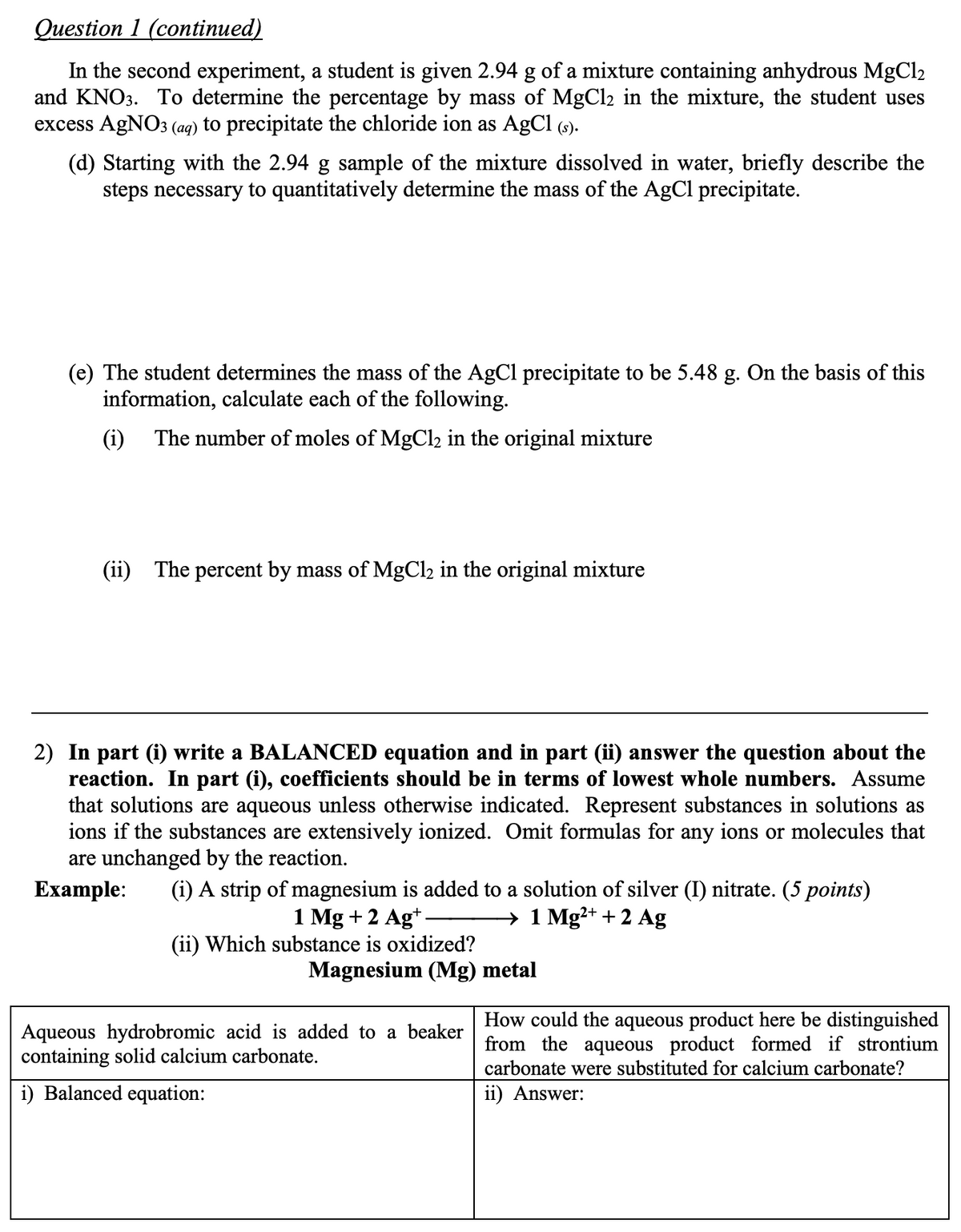1) Answer the following question related to gravimetric analysis. This question continues on the next page. In the first of two experiments, a student is assigned the task of determining the number of moles of water in one mole of a hydrate of magnesium chloride. The student collects the data shown in the following table. 22.347 g Mass of empty container Mass of sample and container Mass of sample and container after first heating Mass of sample and container after second heating Mass of sample and container after third heating 25.825 g 23.982 g 23.976 g 23.977 g (a) Explain why the student can correctly conclude that the hydrate was heated a sufficient number of times in the experiment. (b) Use the data above to perform the following: (i) Calculate the total number of moles of water lost when the sample was heated. (ii) Determine the formula of the hydrated compound. (c) A different student heats the hydrate in an uncovered crucible, and some of the solid spatters out of the crucible. What effect will this spattering have on the calculated mass of the water lost by the hydrate? Justify your answer. Question 1 (continued) In the second experiment, a student is given 2.94 g of a mixture containing anhydrous MgCl2 and KNO3. To determine the percentage by mass of MgCl2 in the mixture, the student uses excess AgNO3 (ag) to precipitate the chloride ion as AgCl (9). (d) Starting with the 2.94 g sample of the mixture dissolved in water, briefly describe the steps necessary to quantitatively determine the mass of the AgCl precipitate. (e) The student determines the mass of the AgCl precipitate to be 5.48 g. On the basis of this information, calculate each of the following. (i) The number of moles of MgCl2 in the original mixture (ii) The percent by mass of MgCl2 in the original mixture 2) In part (i) write a BALANCED equation and in part (ii) answer the question about the reaction. In part (i), coefficients should be in terms of lowest whole numbers. Assume that solutions are aqueous unless otherwise indicated. Represent substances in solutions as ions if the substances are extensively ionized. Omit formulas for any ions or molecules that are unchanged by the reaction. Еxample: (i) A strip of magnesium is added to a solution of silver (I) nitrate. (5 points) → 1 Mg²+ + 2 Ag 1 Mg +2 Ag*- (ii) Which substance is oxidized? Magnesium (Mg) metal Aqueous hydrobromic acid is added to a beaker containing solid calcium carbonate. How could the aqueous product here be distinguished from the aqueous product formed if strontium carbonate were substituted for calcium carbonate? i) Balanced equation: ii) Answer:
1) Answer the following question related to gravimetric analysis. This question continues on the next page. In the first of two experiments, a student is assigned the task of determining the number of moles of water in one mole of a hydrate of magnesium chloride. The student collects the data shown in the following table. 22.347 g Mass of empty container Mass of sample and container Mass of sample and container after first heating Mass of sample and container after second heating Mass of sample and container after third heating 25.825 g 23.982 g 23.976 g 23.977 g (a) Explain why the student can correctly conclude that the hydrate was heated a sufficient number of times in the experiment. (b) Use the data above to perform the following: (i) Calculate the total number of moles of water lost when the sample was heated. (ii) Determine the formula of the hydrated compound. (c) A different student heats the hydrate in an uncovered crucible, and some of the solid spatters out of the crucible. What effect will this spattering have on the calculated mass of the water lost by the hydrate? Justify your answer. Question 1 (continued) In the second experiment, a student is given 2.94 g of a mixture containing anhydrous MgCl2 and KNO3. To determine the percentage by mass of MgCl2 in the mixture, the student uses excess AgNO3 (ag) to precipitate the chloride ion as AgCl (9). (d) Starting with the 2.94 g sample of the mixture dissolved in water, briefly describe the steps necessary to quantitatively determine the mass of the AgCl precipitate. (e) The student determines the mass of the AgCl precipitate to be 5.48 g. On the basis of this information, calculate each of the following. (i) The number of moles of MgCl2 in the original mixture (ii) The percent by mass of MgCl2 in the original mixture 2) In part (i) write a BALANCED equation and in part (ii) answer the question about the reaction. In part (i), coefficients should be in terms of lowest whole numbers. Assume that solutions are aqueous unless otherwise indicated. Represent substances in solutions as ions if the substances are extensively ionized. Omit formulas for any ions or molecules that are unchanged by the reaction. Еxample: (i) A strip of magnesium is added to a solution of silver (I) nitrate. (5 points) → 1 Mg²+ + 2 Ag 1 Mg +2 Ag*- (ii) Which substance is oxidized? Magnesium (Mg) metal Aqueous hydrobromic acid is added to a beaker containing solid calcium carbonate. How could the aqueous product here be distinguished from the aqueous product formed if strontium carbonate were substituted for calcium carbonate? i) Balanced equation: ii) Answer:
Principles of Modern Chemistry
8th Edition
ISBN:9781305079113
Author:David W. Oxtoby, H. Pat Gillis, Laurie J. Butler
Publisher:David W. Oxtoby, H. Pat Gillis, Laurie J. Butler
Chapter11: Solutions
Section: Chapter Questions
Problem 50P
Related questions
Question
100%

Transcribed Image Text:1) Answer the following question related to gravimetric analysis. This question continues on
the next page.
In the first of two experiments, a student is assigned the task of determining the number
of moles of water in one mole of a hydrate of magnesium chloride. The student collects the
data shown in the following table.
22.347 g
Mass of empty container
Mass of sample and container
Mass of sample and container after first heating
Mass of sample and container after second heating
Mass of sample and container after third heating
25.825 g
23.982 g
23.976 g
23.977 g
(a) Explain why the student can correctly conclude that the hydrate was heated a sufficient
number of times in the experiment.
(b) Use the data above to perform the following:
(i)
Calculate the total number of moles of water lost when the sample was heated.
(ii) Determine the formula of the hydrated compound.
(c) A different student heats the hydrate in an uncovered crucible, and some of the solid
spatters out of the crucible. What effect will this spattering have on the calculated mass
of the water lost by the hydrate? Justify your answer.

Transcribed Image Text:Question 1 (continued)
In the second experiment, a student is given 2.94 g of a mixture containing anhydrous MgCl2
and KNO3. To determine the percentage by mass of MgCl2 in the mixture, the student uses
excess AgNO3 (ag) to precipitate the chloride ion as AgCl (9).
(d) Starting with the 2.94 g sample of the mixture dissolved in water, briefly describe the
steps necessary to quantitatively determine the mass of the AgCl precipitate.
(e) The student determines the mass of the AgCl precipitate to be 5.48 g. On the basis of this
information, calculate each of the following.
(i)
The number of moles of MgCl2 in the original mixture
(ii) The percent by mass of MgCl2 in the original mixture
2) In part (i) write a BALANCED equation and in part (ii) answer the question about the
reaction. In part (i), coefficients should be in terms of lowest whole numbers. Assume
that solutions are aqueous unless otherwise indicated. Represent substances in solutions as
ions if the substances are extensively ionized. Omit formulas for any ions or molecules that
are unchanged by the reaction.
Еxample:
(i) A strip of magnesium is added to a solution of silver (I) nitrate. (5 points)
→ 1 Mg²+ + 2 Ag
1 Mg +2 Ag*-
(ii) Which substance is oxidized?
Magnesium (Mg) metal
Aqueous hydrobromic acid is added to a beaker
containing solid calcium carbonate.
How could the aqueous product here be distinguished
from the aqueous product formed if strontium
carbonate were substituted for calcium carbonate?
i) Balanced equation:
ii) Answer:
Expert Solution
This question has been solved!
Explore an expertly crafted, step-by-step solution for a thorough understanding of key concepts.
This is a popular solution!
Trending now
This is a popular solution!
Step by step
Solved in 4 steps

Recommended textbooks for you

Principles of Modern Chemistry
Chemistry
ISBN:
9781305079113
Author:
David W. Oxtoby, H. Pat Gillis, Laurie J. Butler
Publisher:
Cengage Learning


Introductory Chemistry: An Active Learning Approa…
Chemistry
ISBN:
9781305079250
Author:
Mark S. Cracolice, Ed Peters
Publisher:
Cengage Learning

Principles of Modern Chemistry
Chemistry
ISBN:
9781305079113
Author:
David W. Oxtoby, H. Pat Gillis, Laurie J. Butler
Publisher:
Cengage Learning


Introductory Chemistry: An Active Learning Approa…
Chemistry
ISBN:
9781305079250
Author:
Mark S. Cracolice, Ed Peters
Publisher:
Cengage Learning

Chemistry: An Atoms First Approach
Chemistry
ISBN:
9781305079243
Author:
Steven S. Zumdahl, Susan A. Zumdahl
Publisher:
Cengage Learning

World of Chemistry, 3rd edition
Chemistry
ISBN:
9781133109655
Author:
Steven S. Zumdahl, Susan L. Zumdahl, Donald J. DeCoste
Publisher:
Brooks / Cole / Cengage Learning
